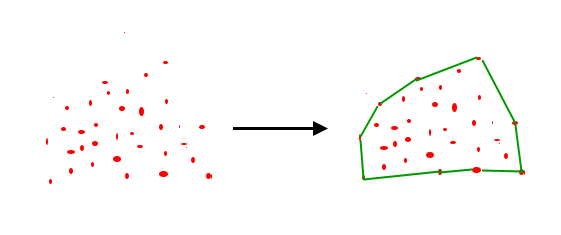Given a set of points in the plane. the convex hull of the set is the smallest convex polygon that contains all the points of it.

https://www.geeksforgeeks.org/convex-hull-set-1-jarviss-algorithm-or-wrapping/
Lin家
Java:
// Java program to find convex hull of a set of points. Refer
// https://www.geeksforgeeks.org/orientation-3-ordered-points/
// for explanation of orientation()
import java.util.*;
class Point
{
int x, y;
Point(int x, int y){
this.x=x;
this.y=y;
}
}
class GFG {
// To find orientation of ordered triplet (p, q, r).
// The function returns following values
// 0 --> p, q and r are colinear
// 1 --> Clockwise
// 2 --> Counterclockwise
public static int orientation(Point p, Point q, Point r)
{
int val = (q.y - p.y) * (r.x - q.x) -
(q.x - p.x) * (r.y - q.y);
if (val == 0) return 0; // collinear
return (val > 0)? 1: 2; // clock or counterclock wise
}
// Prints convex hull of a set of n points.
public static void convexHull(Point points[], int n)
{
// There must be at least 3 points
if (n < 3) return;
// Initialize Result
Vector<Point> hull = new Vector<Point>();
// Find the leftmost point
int l = 0;
for (int i = 1; i < n; i++)
if (points[i].x < points[l].x)
l = i;
// Start from leftmost point, keep moving
// counterclockwise until reach the start point
// again. This loop runs O(h) times where h is
// number of points in result or output.
int p = l, q;
do
{
// Add current point to result
hull.add(points[p]);
// Search for a point 'q' such that
// orientation(p, x, q) is counterclockwise
// for all points 'x'. The idea is to keep
// track of last visited most counterclock-
// wise point in q. If any point 'i' is more
// counterclock-wise than q, then update q.
q = (p + 1) % n;
for (int i = 0; i < n; i++)
{
// If i is more counterclockwise than
// current q, then update q
if (orientation(points[p], points[i], points[q])
== 2)
q = i;
}
// Now q is the most counterclockwise with
// respect to p. Set p as q for next iteration,
// so that q is added to result 'hull'
p = q;
} while (p != l); // While we don't come to first
// point
// Print Result
for (Point temp : hull)
System.out.println("(" + temp.x + ", " +
temp.y + ")");
}
/* Driver program to test above function */
public static void main(String[] args)
{
Point points[] = new Point[7];
points[0]=new Point(0, 3);
points[1]=new Point(2, 3);
points[2]=new Point(1, 1);
points[3]=new Point(2, 1);
points[4]=new Point(3, 0);
points[5]=new Point(0, 0);
points[6]=new Point(3, 3);
int n = points.length;
convexHull(points, n);
}
}